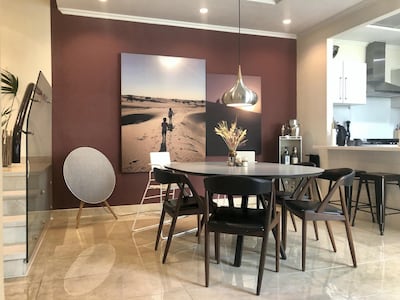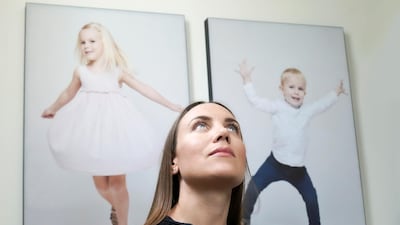Great art possesses the power to silence a room. That's literally the premise of Lotte Raun's company that creates, among other products, sound-absorbing artworks. It all started when Raun and her family shifted into a villa in Dubai, a move she hoped would reduce what she calls "the invisible problem" of echo in her stairwell.
"Being Scandinavian, I love minimal interior design with little but well-picked furniture and only a few textiles," says the mother-of-two from Denmark. "However, our house was not built with acoustics in mind; every single sound would bounce around and take for ever to disappear … it made me feel uncomfortable and tired somehow."
So Raun, 36, drew on inspiration and guidance from her home country, where most accommodation incorporates acoustic ceilings or walls. After a few prototypes, she devised an arty solution that has since evolved into a business aptly named Mute: acoustics, and makes artworks that absorb sounds.
Raun, whose background is industrial design, worked with local suppliers to create “acoustic pictures” featuring photos of her young children, which absorb excess sound on the stairwell while contributing to, rather than compromising, the decor of her Arabian Ranches villa. “They hang there on the wall, beautiful canvas prints, but absorb all sound waves hitting their surface.”
When visitors began appreciating this practical art, Raun decided to launch her first solo business last May. It proved fortuitous timing.
Noise solutions for those working from home

As the pandemic pushed more people towards working from home, the demand for better domestic office spaces also increased. When Raun's full-time job succumbed to the crisis, she opted to focus on Mute, to help more people solve their noisy home issues.
“Often it was not the client who experienced the problem directly,” she says. “Instead, it was the people on the other side of the screen during the Zoom or Teams meeting who complained sound was bad and full of echo or reverb, which severely degraded speech intelligibility.”
The canvases of her Mute Pictures creations are "acoustic transparent", allowing sound waves to reach an acoustic core that absorbs and turns them into micro vibrations. Buyers can customise their own images or choose from a catalogue, which also gives UAE photographers a fresh outlet for their work.
“We believe that acoustics and aesthetics go hand in hand,” says Raun. “For picture products, we have created a collection of simple images that can be printed on the canvas, and we thought it would be a great idea to support local artists and photographers.”
Mute Pictures are made in Dubai, with frames produced in-house in Jebel Ali. The acoustic canvas prints come from a local supplier and any image can be used, such as personal photos for home or branding in the case of corporate clients. Canvases are easily replaceable if owners wish to update.
Raun says her clientele thus far has been a mix of “boardroom and dining room”, but the demand for noise solutions has led to her recruiting three employees, with another two expected to join the company later this year.
Soundproof walls
The product range has also extended to embrace more solutions for residential and commercial spaces. “The indoor acoustic problems here are too big to solve with Mute Pictures alone,” says Raun. “So we decided to launch Mute Felt, sound-absorbing felt panels for the walls and ceiling, which are lighter and more cost-effective [per square metre] than pictures.”
The fabric in question is a soft and porous material made from recycled plastic bottles and can be used to cover more surface area in a room.
Mute is also preparing to release products that will handle intrusive sounds from building exteriors, namely Mute Curtain and Mute Seals.
“Traffic noise or construction noise coming through windows or doors is a problem for many in the UAE, so these are being launched to enable people to enjoy their sleep,” says Raun.
Larger projects always start with an acoustic assessment of the space using a dedicated sound device to measure the reverb time; specifically, how long it takes for a sound to disappear.
“Once the Mute Picture and Mute Felt is installed, we do another measurement to quantify the effect,” says Raun. “It is our way of making the invisible problem more visible for the client and ourselves.”

